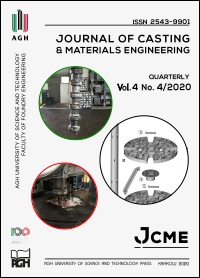Structures for Heat Treatment Assembled from Cast Elements
DOI:
https://doi.org/10.7494/jcme.2020.4.4.53Abstract
Various types of technological equipment individually designed for operation in pit and elevator heat treatment furnaces aredescribed in this article. A common characteristic of these structures is that they are composed of several or several dozen thin-
-walled elements of various shapes and sizes, gravity cast in sand moulds from creep-resistant alloys (austenitic Cr-Ni/Ni-Cr
cast steel and cast nickel alloys). The design of the castings requires the development of a manufacturing technology that can
effectively use the principle of the simultaneous solidification of all components. Properly designed equipment should have minimum
weight, maximum strength, and maximum loading capacity combined with adequate durability and reliability. Two designs
of the equipment for the heat treatment of steel parts were presented. Both designs, as well as their individual components, were
described in detail and illustrated. The main task of the equipment is to form the charge in the furnace and transport this charge
both inside and outside the furnace. The first design is the design of an equipment for the heat treatment of large ring-shaped
parts. The second design is the design of an equipment, whose structure can be modified using various repeatable components. As
a result of these modifications, different variants of the equipment are obtained, allowing for the heat treatment of five different
types of the shafts characterized by different shapes and sizes. The study is of an application nature. It is addressed to engineering
and technical staff dealing with both the design and operation of heat treatment furnaces.
Downloads
References
Steinkusch W. (1987). Hitzebeständiger Stahlguss für Wärmebehandlungsanlagen. Gas Wärme International, 6, 340–346.
Drotlew A. & Piekarski, B. (2020). Connecting castings for operation under conditions of cyclic temperature changes. Journal of Castings & Materials Engineering, 4(1), 16–21.
Davis J.R. (ed.) (1997). Industrial Applications of Heat-Resistant Materials. In: Heat Resistant Materials ASM International, 67–85.
Piekarski B. (2012). Odlewy ze stopów żarowytrzymałych w piecach do obróbki cieplnej. Szczecin: Wydawnictwo Uczelniane Zachodniopomorskiego Uniwersytetu Technologicznego w Szczecinie.
Folders: Lohmann, Cronite, Pose-Marre, Technoalloy, MANOIR PETRO-CHEM, AFE Technologies, NCK, Polcast.
Piekło J. & Pysz S. (2000). Kształtowanie wytrzymałościowe odlewu palety transportowej stosowanej w piecach tunelowych na podstawie analizy numerycznej pola temperatury i stanu naprężenia. Biuletyn Instytutu Odlewnictwa, 1(3), 3–13.
Nandwana D., Bhupendra N.K., Khandelwal N., Bhargava T., Nandwana K. & Jawale G. (2010). Design, finite element analysis and optimization of HRC trays used in heat treatment process. Proceedings of the World Congress on Engineering WCE 2010. II, 1149–1154.
Bajwoluk A. & Gutowski P. (2016). Thermal stresses in the wall connections of cast grate structures. Archives of Foundry Engineering, 4, 11–16.
Bajwoluk A. & Gutowski P. (2019). Stress and crack propagation in the surface layer of carburized stable austenitic alloys during cooling. Materials at High Temperatures, 36(1), 9–18. Doi: 10.1080/09603409.2018.1448528.
Downloads
Published
Issue
Section
License
Copyright (c) 2020 Bogdan Piekarski

This work is licensed under a Creative Commons Attribution 4.0 International License.
How to Cite
Accepted 2020-09-17
Published 2020-11-04


